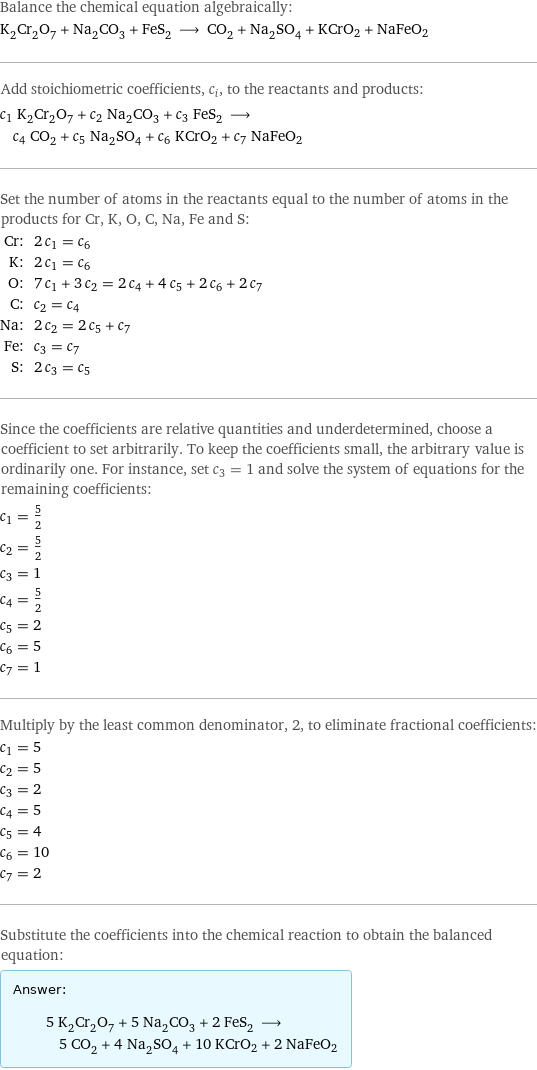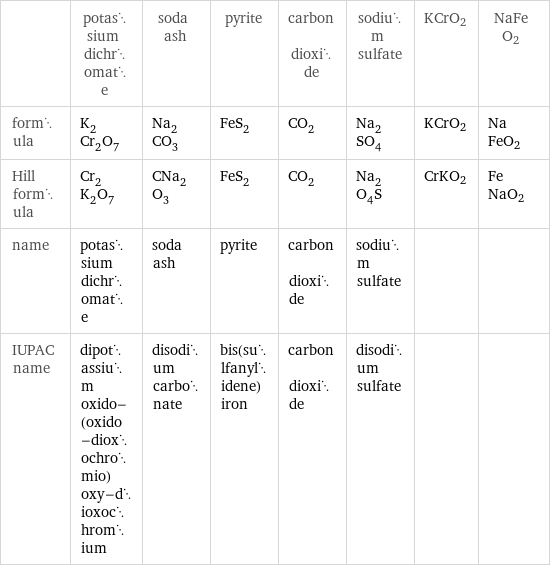Input interpretation

K_2Cr_2O_7 potassium dichromate + Na_2CO_3 soda ash + FeS_2 pyrite ⟶ CO_2 carbon dioxide + Na_2SO_4 sodium sulfate + KCrO2 + NaFeO2
Balanced equation

Balance the chemical equation algebraically: K_2Cr_2O_7 + Na_2CO_3 + FeS_2 ⟶ CO_2 + Na_2SO_4 + KCrO2 + NaFeO2 Add stoichiometric coefficients, c_i, to the reactants and products: c_1 K_2Cr_2O_7 + c_2 Na_2CO_3 + c_3 FeS_2 ⟶ c_4 CO_2 + c_5 Na_2SO_4 + c_6 KCrO2 + c_7 NaFeO2 Set the number of atoms in the reactants equal to the number of atoms in the products for Cr, K, O, C, Na, Fe and S: Cr: | 2 c_1 = c_6 K: | 2 c_1 = c_6 O: | 7 c_1 + 3 c_2 = 2 c_4 + 4 c_5 + 2 c_6 + 2 c_7 C: | c_2 = c_4 Na: | 2 c_2 = 2 c_5 + c_7 Fe: | c_3 = c_7 S: | 2 c_3 = c_5 Since the coefficients are relative quantities and underdetermined, choose a coefficient to set arbitrarily. To keep the coefficients small, the arbitrary value is ordinarily one. For instance, set c_3 = 1 and solve the system of equations for the remaining coefficients: c_1 = 5/2 c_2 = 5/2 c_3 = 1 c_4 = 5/2 c_5 = 2 c_6 = 5 c_7 = 1 Multiply by the least common denominator, 2, to eliminate fractional coefficients: c_1 = 5 c_2 = 5 c_3 = 2 c_4 = 5 c_5 = 4 c_6 = 10 c_7 = 2 Substitute the coefficients into the chemical reaction to obtain the balanced equation: Answer: | | 5 K_2Cr_2O_7 + 5 Na_2CO_3 + 2 FeS_2 ⟶ 5 CO_2 + 4 Na_2SO_4 + 10 KCrO2 + 2 NaFeO2
Structures

+ + ⟶ + + KCrO2 + NaFeO2
Names

potassium dichromate + soda ash + pyrite ⟶ carbon dioxide + sodium sulfate + KCrO2 + NaFeO2
Equilibrium constant
![Construct the equilibrium constant, K, expression for: K_2Cr_2O_7 + Na_2CO_3 + FeS_2 ⟶ CO_2 + Na_2SO_4 + KCrO2 + NaFeO2 Plan: • Balance the chemical equation. • Determine the stoichiometric numbers. • Assemble the activity expression for each chemical species. • Use the activity expressions to build the equilibrium constant expression. Write the balanced chemical equation: 5 K_2Cr_2O_7 + 5 Na_2CO_3 + 2 FeS_2 ⟶ 5 CO_2 + 4 Na_2SO_4 + 10 KCrO2 + 2 NaFeO2 Assign stoichiometric numbers, ν_i, using the stoichiometric coefficients, c_i, from the balanced chemical equation in the following manner: ν_i = -c_i for reactants and ν_i = c_i for products: chemical species | c_i | ν_i K_2Cr_2O_7 | 5 | -5 Na_2CO_3 | 5 | -5 FeS_2 | 2 | -2 CO_2 | 5 | 5 Na_2SO_4 | 4 | 4 KCrO2 | 10 | 10 NaFeO2 | 2 | 2 Assemble the activity expressions accounting for the state of matter and ν_i: chemical species | c_i | ν_i | activity expression K_2Cr_2O_7 | 5 | -5 | ([K2Cr2O7])^(-5) Na_2CO_3 | 5 | -5 | ([Na2CO3])^(-5) FeS_2 | 2 | -2 | ([FeS2])^(-2) CO_2 | 5 | 5 | ([CO2])^5 Na_2SO_4 | 4 | 4 | ([Na2SO4])^4 KCrO2 | 10 | 10 | ([KCrO2])^10 NaFeO2 | 2 | 2 | ([NaFeO2])^2 The equilibrium constant symbol in the concentration basis is: K_c Mulitply the activity expressions to arrive at the K_c expression: Answer: | | K_c = ([K2Cr2O7])^(-5) ([Na2CO3])^(-5) ([FeS2])^(-2) ([CO2])^5 ([Na2SO4])^4 ([KCrO2])^10 ([NaFeO2])^2 = (([CO2])^5 ([Na2SO4])^4 ([KCrO2])^10 ([NaFeO2])^2)/(([K2Cr2O7])^5 ([Na2CO3])^5 ([FeS2])^2)](../image_source/cbd34f606eea102e0d1742fafd491483.png)
Construct the equilibrium constant, K, expression for: K_2Cr_2O_7 + Na_2CO_3 + FeS_2 ⟶ CO_2 + Na_2SO_4 + KCrO2 + NaFeO2 Plan: • Balance the chemical equation. • Determine the stoichiometric numbers. • Assemble the activity expression for each chemical species. • Use the activity expressions to build the equilibrium constant expression. Write the balanced chemical equation: 5 K_2Cr_2O_7 + 5 Na_2CO_3 + 2 FeS_2 ⟶ 5 CO_2 + 4 Na_2SO_4 + 10 KCrO2 + 2 NaFeO2 Assign stoichiometric numbers, ν_i, using the stoichiometric coefficients, c_i, from the balanced chemical equation in the following manner: ν_i = -c_i for reactants and ν_i = c_i for products: chemical species | c_i | ν_i K_2Cr_2O_7 | 5 | -5 Na_2CO_3 | 5 | -5 FeS_2 | 2 | -2 CO_2 | 5 | 5 Na_2SO_4 | 4 | 4 KCrO2 | 10 | 10 NaFeO2 | 2 | 2 Assemble the activity expressions accounting for the state of matter and ν_i: chemical species | c_i | ν_i | activity expression K_2Cr_2O_7 | 5 | -5 | ([K2Cr2O7])^(-5) Na_2CO_3 | 5 | -5 | ([Na2CO3])^(-5) FeS_2 | 2 | -2 | ([FeS2])^(-2) CO_2 | 5 | 5 | ([CO2])^5 Na_2SO_4 | 4 | 4 | ([Na2SO4])^4 KCrO2 | 10 | 10 | ([KCrO2])^10 NaFeO2 | 2 | 2 | ([NaFeO2])^2 The equilibrium constant symbol in the concentration basis is: K_c Mulitply the activity expressions to arrive at the K_c expression: Answer: | | K_c = ([K2Cr2O7])^(-5) ([Na2CO3])^(-5) ([FeS2])^(-2) ([CO2])^5 ([Na2SO4])^4 ([KCrO2])^10 ([NaFeO2])^2 = (([CO2])^5 ([Na2SO4])^4 ([KCrO2])^10 ([NaFeO2])^2)/(([K2Cr2O7])^5 ([Na2CO3])^5 ([FeS2])^2)
Rate of reaction
![Construct the rate of reaction expression for: K_2Cr_2O_7 + Na_2CO_3 + FeS_2 ⟶ CO_2 + Na_2SO_4 + KCrO2 + NaFeO2 Plan: • Balance the chemical equation. • Determine the stoichiometric numbers. • Assemble the rate term for each chemical species. • Write the rate of reaction expression. Write the balanced chemical equation: 5 K_2Cr_2O_7 + 5 Na_2CO_3 + 2 FeS_2 ⟶ 5 CO_2 + 4 Na_2SO_4 + 10 KCrO2 + 2 NaFeO2 Assign stoichiometric numbers, ν_i, using the stoichiometric coefficients, c_i, from the balanced chemical equation in the following manner: ν_i = -c_i for reactants and ν_i = c_i for products: chemical species | c_i | ν_i K_2Cr_2O_7 | 5 | -5 Na_2CO_3 | 5 | -5 FeS_2 | 2 | -2 CO_2 | 5 | 5 Na_2SO_4 | 4 | 4 KCrO2 | 10 | 10 NaFeO2 | 2 | 2 The rate term for each chemical species, B_i, is 1/ν_i(Δ[B_i])/(Δt) where [B_i] is the amount concentration and t is time: chemical species | c_i | ν_i | rate term K_2Cr_2O_7 | 5 | -5 | -1/5 (Δ[K2Cr2O7])/(Δt) Na_2CO_3 | 5 | -5 | -1/5 (Δ[Na2CO3])/(Δt) FeS_2 | 2 | -2 | -1/2 (Δ[FeS2])/(Δt) CO_2 | 5 | 5 | 1/5 (Δ[CO2])/(Δt) Na_2SO_4 | 4 | 4 | 1/4 (Δ[Na2SO4])/(Δt) KCrO2 | 10 | 10 | 1/10 (Δ[KCrO2])/(Δt) NaFeO2 | 2 | 2 | 1/2 (Δ[NaFeO2])/(Δt) (for infinitesimal rate of change, replace Δ with d) Set the rate terms equal to each other to arrive at the rate expression: Answer: | | rate = -1/5 (Δ[K2Cr2O7])/(Δt) = -1/5 (Δ[Na2CO3])/(Δt) = -1/2 (Δ[FeS2])/(Δt) = 1/5 (Δ[CO2])/(Δt) = 1/4 (Δ[Na2SO4])/(Δt) = 1/10 (Δ[KCrO2])/(Δt) = 1/2 (Δ[NaFeO2])/(Δt) (assuming constant volume and no accumulation of intermediates or side products)](../image_source/3b6764c759424933155faa618f822db1.png)
Construct the rate of reaction expression for: K_2Cr_2O_7 + Na_2CO_3 + FeS_2 ⟶ CO_2 + Na_2SO_4 + KCrO2 + NaFeO2 Plan: • Balance the chemical equation. • Determine the stoichiometric numbers. • Assemble the rate term for each chemical species. • Write the rate of reaction expression. Write the balanced chemical equation: 5 K_2Cr_2O_7 + 5 Na_2CO_3 + 2 FeS_2 ⟶ 5 CO_2 + 4 Na_2SO_4 + 10 KCrO2 + 2 NaFeO2 Assign stoichiometric numbers, ν_i, using the stoichiometric coefficients, c_i, from the balanced chemical equation in the following manner: ν_i = -c_i for reactants and ν_i = c_i for products: chemical species | c_i | ν_i K_2Cr_2O_7 | 5 | -5 Na_2CO_3 | 5 | -5 FeS_2 | 2 | -2 CO_2 | 5 | 5 Na_2SO_4 | 4 | 4 KCrO2 | 10 | 10 NaFeO2 | 2 | 2 The rate term for each chemical species, B_i, is 1/ν_i(Δ[B_i])/(Δt) where [B_i] is the amount concentration and t is time: chemical species | c_i | ν_i | rate term K_2Cr_2O_7 | 5 | -5 | -1/5 (Δ[K2Cr2O7])/(Δt) Na_2CO_3 | 5 | -5 | -1/5 (Δ[Na2CO3])/(Δt) FeS_2 | 2 | -2 | -1/2 (Δ[FeS2])/(Δt) CO_2 | 5 | 5 | 1/5 (Δ[CO2])/(Δt) Na_2SO_4 | 4 | 4 | 1/4 (Δ[Na2SO4])/(Δt) KCrO2 | 10 | 10 | 1/10 (Δ[KCrO2])/(Δt) NaFeO2 | 2 | 2 | 1/2 (Δ[NaFeO2])/(Δt) (for infinitesimal rate of change, replace Δ with d) Set the rate terms equal to each other to arrive at the rate expression: Answer: | | rate = -1/5 (Δ[K2Cr2O7])/(Δt) = -1/5 (Δ[Na2CO3])/(Δt) = -1/2 (Δ[FeS2])/(Δt) = 1/5 (Δ[CO2])/(Δt) = 1/4 (Δ[Na2SO4])/(Δt) = 1/10 (Δ[KCrO2])/(Δt) = 1/2 (Δ[NaFeO2])/(Δt) (assuming constant volume and no accumulation of intermediates or side products)
Chemical names and formulas

| potassium dichromate | soda ash | pyrite | carbon dioxide | sodium sulfate | KCrO2 | NaFeO2 formula | K_2Cr_2O_7 | Na_2CO_3 | FeS_2 | CO_2 | Na_2SO_4 | KCrO2 | NaFeO2 Hill formula | Cr_2K_2O_7 | CNa_2O_3 | FeS_2 | CO_2 | Na_2O_4S | CrKO2 | FeNaO2 name | potassium dichromate | soda ash | pyrite | carbon dioxide | sodium sulfate | | IUPAC name | dipotassium oxido-(oxido-dioxochromio)oxy-dioxochromium | disodium carbonate | bis(sulfanylidene)iron | carbon dioxide | disodium sulfate | |
Substance properties

| potassium dichromate | soda ash | pyrite | carbon dioxide | sodium sulfate | KCrO2 | NaFeO2 molar mass | 294.18 g/mol | 105.99 g/mol | 120 g/mol | 44.009 g/mol | 142.04 g/mol | 123.09 g/mol | 110.83 g/mol phase | solid (at STP) | solid (at STP) | | gas (at STP) | solid (at STP) | | melting point | 398 °C | 851 °C | | -56.56 °C (at triple point) | 884 °C | | boiling point | | 1600 °C | | -78.5 °C (at sublimation point) | 1429 °C | | density | 2.67 g/cm^3 | | 4.89 g/cm^3 | 0.00184212 g/cm^3 (at 20 °C) | 2.68 g/cm^3 | | solubility in water | | soluble | | | soluble | | dynamic viscosity | | 0.00355 Pa s (at 900 °C) | | 1.491×10^-5 Pa s (at 25 °C) | | | odor | odorless | | odorless | odorless | | |
Units
